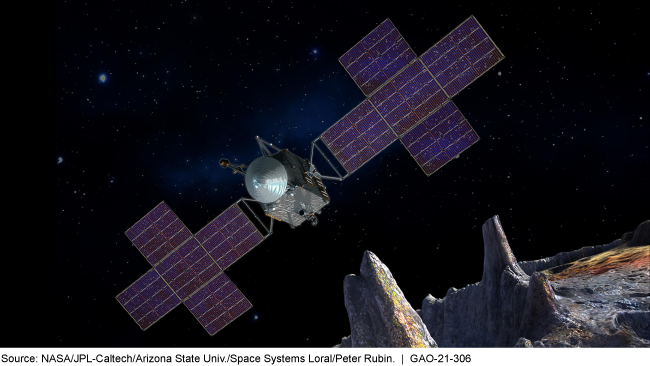NASA: Assessments of Major Projects
Fast Facts
NASA plans to invest over $69 billion dollars in its major projects to continue exploring the moon, Sun, Earth, and solar system.
This is our 13th annual assessment of NASA's major projects. It includes snapshot profiles of 33 major projects.
In the last year, the major projects collectively surpassed their cost estimates by over $1 billion. They also surpassed their schedules by 3 years. Although COVID-19 did not have significant effects on costs and schedules this year, it will have effects moving forward. The number of major projects is also expected to grow in the future.
NASA's acquisition management is on our High Risk list.
Artist Rendition of the Psyche Spacecraft That Will Explore a Metal-Rich Asteroid between Mars and Jupiter

Highlights
What GAO Found
The National Aeronautics and Space Administration's (NASA) portfolio of major projects in the development stage of the acquisition process continues to experience cost increases and schedule delays. This marks the fifth year in a row that cumulative cost and schedule performance deteriorated (see figure). The cumulative cost growth is currently $9.6 billion, driven by nine projects; however, $7.1 billion of this cost growth stems from two projects—the James Webb Space Telescope and the Space Launch System. These two projects account for about half of the cumulative schedule delays. The portfolio also continues to grow, with more projects expected to reach development in the next year.
Cumulative Cost and Schedule Performance for NASA's Major Projects in Development

The majority of projects are managing the effects of the pandemic by using cost and schedule reserves—extra money or time set aside to accommodate unforeseen risks or delays. However, the full effects of COVID-19 are not yet known, and these reserves may be insufficient for several projects.
Most projects met a GAO best practice related to technology maturity, but few met a best practice to demonstrate a stable design.
- Most projects that held a preliminary design review demonstrated that the project's critical technologies—new or novel technologies needed to meet requirements—were mature. By doing so, the projects demonstrated the technologies can perform as needed under realistic conditions before committing to use them in the system.
- Most projects that held a critical design review fell short of meeting the best practice of releasing 90 percent of design drawings at that review. The average was approximately 70 percent. Design stability is important because late design changes can lead to costly rework and delays.
NASA and GAO have taken steps to identify and assess metrics that contribute to project success. For example, GAO is conducting work to determine if there are updated best practices for product development. In the interim, GAO continues to believe design drawings are a useful indicator of design stability.
Why GAO Did This Study
This report provides a snapshot of how well NASA is planning and executing its major projects, which are those with costs of over $250 million. NASA plans to invest at least $69 billion in its major projects to continue exploring Earth and the solar system.
Congressional conferees included a provision for GAO to prepare status reports on selected large-scale NASA programs, projects, and activities. This is GAO's 13th annual assessment. This report assesses (1) the cost and schedule performance of NASA's major projects, including the effects of COVID-19; and (2) the development and maturity of technologies and progress in achieving design stability. The report also includes assessments of 33 major projects.
To conduct its review, GAO collected questionnaire data; analyzed cost, schedule, technology maturity, and other data; reviewed project status reports; and interviewed NASA officials. The reviewed projects include those in formulation, which takes a project through preliminary design, and those in development, which includes building and launching the system.
Recommendations
In prior work, GAO has made multiple recommendations to improve NASA's acquisition of major projects. NASA generally agreed with those recommendations and implemented changes in response to many. However, NASA has not fully addressed 21 recommendations as of March 2021.
